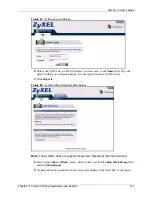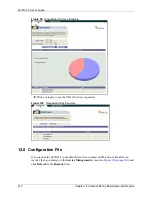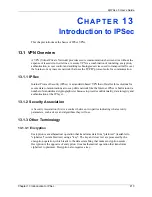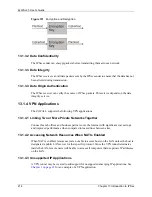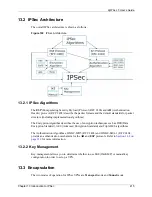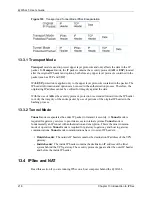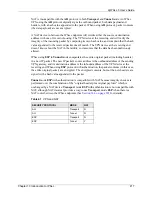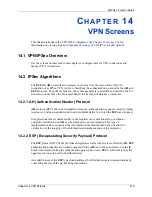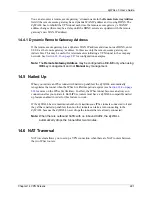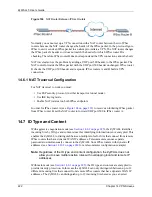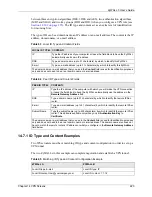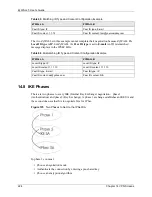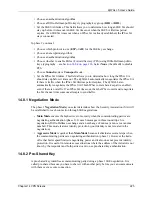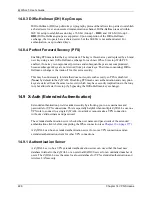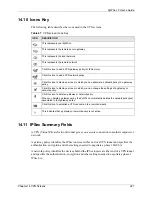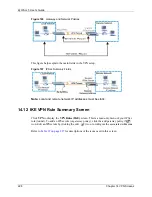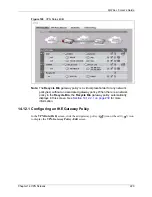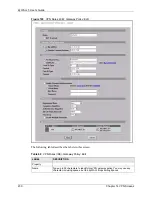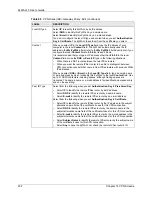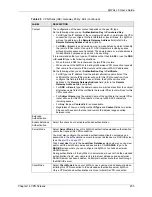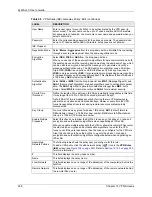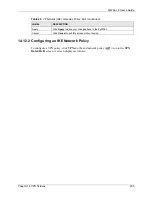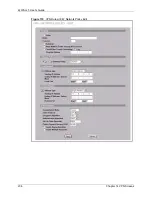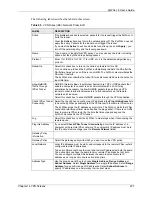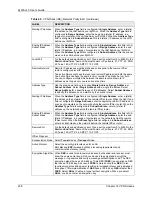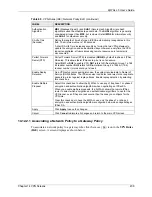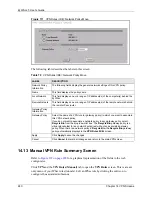
ZyWALL 5 User’s Guide
Chapter 14 VPN Screens
225
• Choose an authentication algorithm.
• Choose a Diffie-Hellman public-key cryptography key group (
DH1
or
DH2
)
.
• Set the IKE SA lifetime. This field allows you to determine how long an IKE SA should
stay up before it times out. An IKE SA times out when the IKE SA lifetime period
expires. If an IKE SA times out when an IPSec SA is already established, the IPSec SA
stays connected.
In phase 2 you must:
• Choose which protocol to use (
ESP
or
AH
) for the IKE key exchange.
• Choose an encryption algorithm.
• Choose an authentication algorithm
• Choose whether to enable Perfect Forward Secrecy (PFS) using Diffie-Hellman public-
key cryptography – see
. Select
None
(the default) to disable
PFS.
• Choose
Tunnel
mode or
Transport
mode.
• Set the IPSec SA lifetime. This field allows you to determine how long the IPSec SA
should stay up before it times out. The ZyWALL automatically renegotiates the IPSec SA
if there is traffic when the IPSec SA lifetime period expires. The ZyWALL also
automatically renegotiates the IPSec SA if both IPSec routers have keep alive enabled,
even if there is no traffic. If an IPSec SA times out, then the IPSec router must renegotiate
the SA the next time someone attempts to send traffic.
14.8.1 Negotiation Mode
The phase 1
Negotiation Mode
you select determines how the Security Association (SA) will
be established for each connection through IKE negotiations.
•
Main Mode
ensures the highest level of security when the communicating parties are
negotiating authentication (phase 1). It uses 6 messages in three round trips: SA
negotiation, Diffie-Hellman exchange and an exchange of nonces (a nonce is a random
number). This mode features identity protection (your identity is not revealed in the
negotiation).
•
Aggressive Mode
is quicker than
Main Mode
because it eliminates several steps when
the communicating parties are negotiating authentication (phase 1). However the trade-
off is that faster speed limits its negotiating power and it also does not provide identity
protection. It is useful in remote access situations where the address of the initiator is not
know by the responder and both parties want to use pre-shared key authentication.
14.8.2 Pre-Shared Key
A pre-shared key identifies a communicating party during a phase 1 IKE negotiation. It is
called pre-shared because you have to share it with another party before you can communicate
with them over a secure connection.
Summary of Contents for ZyXEL ZyWALL 5
Page 1: ...ZyWALL 5 Internet Security Appliance User s Guide Version 3 64 3 2005 ...
Page 2: ......
Page 26: ...ZyWALL 5 User s Guide 24 ...
Page 44: ...ZyWALL 5 User s Guide 42 ...
Page 86: ...ZyWALL 5 User s Guide 84 Chapter 3 Wizard Setup ...
Page 96: ...ZyWALL 5 User s Guide 94 Chapter 4 LAN Screens ...
Page 102: ...ZyWALL 5 User s Guide 100 Chapter 5 Bridge Screens ...
Page 130: ...ZyWALL 5 User s Guide 128 Chapter 7 WAN Screens Figure 45 WAN PPPoE Encapsulation ...
Page 138: ...ZyWALL 5 User s Guide 136 Chapter 7 WAN Screens Figure 50 Dial Backup Setup ...
Page 144: ...ZyWALL 5 User s Guide 142 Chapter 7 WAN Screens ...
Page 152: ...ZyWALL 5 User s Guide 150 Chapter 8 DMZ Screens ...
Page 179: ...ZyWALL 5 User s Guide Chapter 10 Firewall Screens 177 Figure 73 My Service Rule Configuration ...
Page 220: ...ZyWALL 5 User s Guide 218 Chapter 13 Introduction to IPSec ...
Page 238: ...ZyWALL 5 User s Guide 236 Chapter 14 VPN Screens Figure 110 VPN Rules IKE Network Policy Edit ...
Page 261: ...ZyWALL 5 User s Guide Chapter 15 Certificates 259 Figure 122 My Certificate Details ...
Page 280: ...ZyWALL 5 User s Guide 278 Chapter 16 Authentication Server Figure 133 Local User Database ...
Page 317: ...ZyWALL 5 User s Guide Chapter 19 Bandwidth Management 315 ...
Page 318: ...ZyWALL 5 User s Guide 316 Chapter 19 Bandwidth Management ...
Page 352: ...ZyWALL 5 User s Guide 350 Chapter 21 Remote Management ...
Page 366: ...ZyWALL 5 User s Guide 364 Chapter 23 Logs Screens Figure 188 Log Settings ...
Page 389: ...ZyWALL 5 User s Guide Chapter 24 Maintenance 387 Figure 210 Restart Screen ...
Page 390: ...ZyWALL 5 User s Guide 388 Chapter 24 Maintenance ...
Page 416: ...ZyWALL 5 User s Guide 414 Chapter 27 WAN and Dial Backup Setup ...
Page 432: ...ZyWALL 5 User s Guide 430 Chapter 30 DMZ Setup ...
Page 492: ...ZyWALL 5 User s Guide 490 Chapter 37 System Information Diagnosis ...
Page 508: ...ZyWALL 5 User s Guide 506 Chapter 38 Firmware and Configuration File Maintenance ...
Page 520: ...ZyWALL 5 User s Guide 518 Chapter 40 Remote Management ...
Page 536: ...ZyWALL 5 User s Guide 534 Chapter 42 Troubleshooting Figure 343 Java Sun ...
Page 564: ...ZyWALL 5 User s Guide 562 Appendix C IP Subnetting ...
Page 570: ...ZyWALL 5 User s Guide 568 Appendix E PPTP ...
Page 571: ...ZyWALL 5 User s Guide 569 ...
Page 572: ...ZyWALL 5 User s Guide 570 ...
Page 590: ...ZyWALL 5 User s Guide 588 Appendix G Triangle Route ...
Page 620: ...ZyWALL 5 User s Guide 618 Appendix J Importing Certificates ...
Page 622: ...ZyWALL 5 User s Guide 620 Appendix K Command Interpreter ...
Page 628: ...ZyWALL 5 User s Guide 626 Appendix L Firewall Commands ...
Page 632: ...ZyWALL 5 User s Guide 630 Appendix M NetBIOS Filter Commands ...
Page 638: ...ZyWALL 5 User s Guide 636 Appendix O Brute Force Password Guessing Protection ...
Page 660: ...ZyWALL 5 User s Guide 658 Appendix Q Log Descriptions ...

